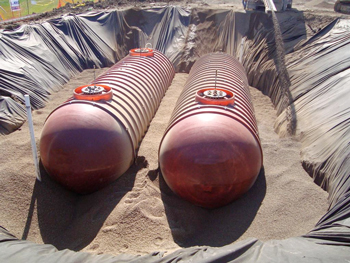 |
|
Please note: This summary is provided to help you understand the regulations. Consult the references provided for links to the full text of the regulations.
This section covers regulations for underground storage tanks used for petroleum fuel storage.
Who is covered by the regulations? Federal UST regulations apply to underground tanks storing more than 110 gallons of either petroleum or certain hazardous substances. State UST regulations also exist, most of which are similar to the federal rules. However, some tanks that are excluded under federal rules may be covered by some state rules, and some state rules may be more stringent than federal rules. What is the purpose of the regulations? There are approximately 600,000 active underground storage tanks (USTs) nationwide that store petroleum or hazardous substances and there have been nearly one-half million confirmed releases from USTs. Leaking underground storage tank systems pose a significant threat to groundwater quality in the United States, which supplies drinking water to approximately 50 percent of the nation's overall population and 99 percent of the population in rural areas. Any tank can leak, and underground tanks present particular challenges because leaks can go unnoticed. Small leak rates can become major releases over time. Both at federal and state levels, UST regulations are intended to address leaks preemptively, by requiring facility operators to act before leaks occur. The rules require facility operators to develop plans that generally include effective monitoring of petroleum and chemical storage systems. In addition, the rules impose deadlines for removal of older USTs, so they can be replaced, before they fail, by systems built to present standards. The federal regulations for underground storage tanks can be found at 40 CFR 280. Below is a brief summary of the requirements with links to specific sections of the regulations. If your facility has a regulated underground storage tank, you must take these steps:
In June 2015, EPA issued the 2015 underground storage tank regulation and the 2015 state program approval regulation. The revisions strengthen the 1988 federal underground storage tank (UST) regulations by increasing emphasis on properly operating and maintaining UST equipment. The 2015 regulation changes certain portions of the 1988 underground storage tank technical regulation in 40 CFR 280. The changes establish federal requirements that are similar to key portions of the Energy Policy Act of 2005. In addition, EPA added new operation and maintenance requirements and addressed UST systems deferred in the 1988 UST regulation. The changes include:
EPA recognized that, because of the size and diversity of the regulated community, state and local governments are in the best position to oversee underground storage tanks. Therefore, most states have assumed responsibility for USTs (for more information, see state program approval process). State programs must be at least as stringent as the EPA UST regulations. All 50 states and the District of Columbia have approved "state" programs. EPA provides separate web pages listing the status of each state, together with statistics and contact information.
One way to avoid the expense of compliance with UST rules is to consider closing your USTs all together. If you could be sure you would have access to fuel 24-hours a day at a conveniently located station, would you still need your USTs? Such an arrangement would transfer the responsibility of complying with UST rules to the operator of a dedicated facility who has presumably built compliance into the operation from the beginning. In addition, the billing systems now used by many motor fuel suppliers may enable you to track fuel usage more closely than you do at your on-site facility. Another option is to consolidate your own and other companies' refueling facilities at a single site convenient for all your vehicles. This site could have unattended fuel pumps activated by key cards, so that you would receive detailed records of refueling by your employees. These options can reduce or eliminate your responsibility for petroleum releases, costly cleanups, and liability insurance. In addition, if you remove all your USTs in favor of off-site refueling, you will also avoid some of the environmental concerns that sometimes block property transfers or make bankers reluctant to lend money. You can close your UST temporarily or permanently. In either case, tanks must be closed properly. EPA provides a web page with additional information on tank closure. The following are prevention measures to prevent and detect UST releases. Please note that some of these measures are required by federal and state regulations:
EPA Office of Underground Storage Tanks (OUST). Management of underground storage tanks (USTs) for petroleum and other products, response to tank leaks, and reuse of USTsites. Regulations Pertaining to Underground Storage Tanks. Links to applicable sections of the Code of Federal Regulations. Storage Tank State Resource Locator. Use this tool to locate state regulations and/or published guidelines for petroleum storage tanks.
|
 Underground Storage Tanks (USTs)
Underground Storage Tanks (USTs)